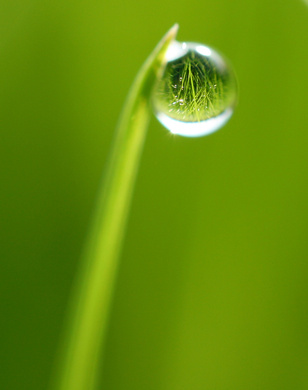During dry and hot weather the need to water your green properly can’t be over emphasised. Although it can be tempting to let the green burn to achieve speed, this can turn to disaster and cause the green to fail later in the season.
So what is the right way to water your green?
Whatever method of watering you are using, whether it be an automatic pop up system, hose and sprinkler or simply hand watering with a hose, the rule you should follow is “deeply not daily”. It is better to give the green a really heavy watering twice or three times a week, than it is to water lightly every night.
Light applications usually don’t address the need to get water deeper into the rootzone; more of the water is lost to evaporation and if too light, might not even penetrate the surface.
How much to apply?
Again as a general rule, in the UK during a rainless week the average green will lose about 25mm of water to evaporation and plant transpiration combined; this will be significantly higher during periods of extreme heat. This means that you should aim to replace at least 25mm through irrigation over the week. Of course you can subtract any significant rainfall the green receives from that figure. A simple rain gauge can help a lot here.
How many minutes of sprinkler time is that?
Most automatic irrigation systems on UK greens are of inadequate design to deliver the required amount of water evenly across the entire green. The centre of the green usually does not receive enough water and you should make sure that additional water is applied in the centre by hose. The typical 4 sprinkler bowling green system is also hampered in its performance by a lack of tank capacity, with long waits between applications for tank filling.
However, with all of these problems put aside, the average automatic system will deliver 1mm of water for every 2 minutes of run time. To deliver our 25mm requirement in a week, this would mean running each sprinkler for 50 minutes per week.
The danger in relying too heavily on automatic systems is that although they apply the water evenly across most of the green surface, they do tend to under water the centre of the green. Another factor to consider is the fact that greens don’t dry out evenly and some areas will usually need more water than others and that brings us to Localised Dry Patch.
How to address hot spots and dry patches.
Localised Dry Patch (LDP) is a real problem on greens throughout the UK. This is a disorder that results in random areas of the green surface being unable to take in water, in other words they become hydrophobic or water repellent. These areas must be treated differently:
First of all you must open the surface to allow water to penetrate into the turf. This can be achieved by hand tiner or a sarrell roller. It is then essential to hand water at high volume, preferably using a 19mm hose connected to the irrigation system. Additional benefits can be gained by applying a wetting agent alongside or prior to watering. Dry patches need to be watered by hand regularly with time given between soakings to allow the water to penetrate the soil.

